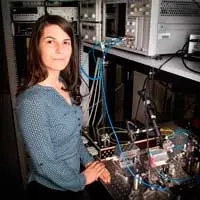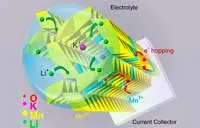Electronics News
Archive : 13 December 2016 год
 A five-year EPSRC funded project led by University College London has developed an x-ray imaging technology that is claimed to have applications ranging from healthcare and security to materials analysis.
A five-year EPSRC funded project led by University College London has developed an x-ray imaging technology that is claimed to have applications ranging from healthcare and security to materials analysis.
The technique is called phase-contrast x-ray imaging. Instead of measuring the extent to which tissue or materials absorb radiation – as in conventional x-ray imaging – it measures the physical effect that passing through different types of tissue or material has on the speed of the x-ray itself.
The researchers say that, compared with conventional x-rays, the technology can enable the earlier identification of tumours in living tissue, while spotting smaller cracks and defects in materials. The approach can also identify different shapes and different types of matter – something which could only be achieved with conventional x-ray systems if prohibitively high doses of radiation were used.
UCL Professor Alessandro Olivo, who led the project team, said: “The technique has been around for decades, but has been limited to large-scale synchrotron facilities, such as Diamond Light Source. We’ve advanced this technology to make it viable for day-to-day use in medicine, security applications, industrial production lines, materials science, non-destructive testing, the archaeology and heritage sector, and a whole range of other fields.”
Under licence, Nikon Metrology UK has incorporated the technology into a prototype security scanner, which could provide enhanced threat detection against weapons and explosives concealed, for example, in baggage.
Meanwhile, a three year project supported by the Wellcome Trust will see Nikon and UCL, in collaboration with Barts Heath and Queen Mary University of London, develop a prototype scanner for use during breast cancer surgery.
Prof Olivo added: “This has the potential to be incredibly versatile, game-changing technology. We’re currently negotiating with a number of companies to explore how it could be put to practical use. There’s really no limit to the benefits this technique could deliver.”
Author
Graham Pitcher
Source: www.newelectronics.co.uk
 Data rates of up to 100Gbit/s in ultrafast photodetectors have been reported by researchers from the Graphene Flagship working at TU Vienna, Austria and AMO, Germany. The scientists claim the photodetectors have the highest bandwidth for graphene-based devices.
Data rates of up to 100Gbit/s in ultrafast photodetectors have been reported by researchers from the Graphene Flagship working at TU Vienna, Austria and AMO, Germany. The scientists claim the photodetectors have the highest bandwidth for graphene-based devices.
Simone Schuler, a researcher at TU Vienna, pictured, explained the importance of increasing data capabilities. “These kinds of photodetectors are typically used in optical data links, which form the backbone of the internet. The maximum operation speed of a photodetector defines the maximum data rate the detector can receive. So, the faster the photodetector, the more data it can receive.”
The photodetector is said to be highly sensitive, supposedly due to its compact structure. This enables its use alongside other optoelectronic devices, including switches in dense, integrated chips.
“This could open the path towards a complete integration on one CMOS chip. Graphene will be the enabling material for realising high performance photodetectors on a silicon platform,” added Schuler.
In the photodetectors, light is guided into a slot waveguide that is covered with graphene. Under specific electrical conditions in the graphene, the light in the waveguide generates a current in the graphene via the photothermoelectric effect, converting light into an electrical signal. The sensitivity of the detector can be tuned electrically without compromising the speed, enabling the high bandwidth and ultrafast data rate.
Author
Peggy Lee
Source: www.newelectronics.co.uk
 Looking to address a growing need for sensor aggregation in a range of applications, Lattice Semiconductor has expanded its iCE40 Ultra range of FPGAs with a device offering 1.1Mbit of RAM, up to eight DSP blocks and more I/O than previous family members.
Looking to address a growing need for sensor aggregation in a range of applications, Lattice Semiconductor has expanded its iCE40 Ultra range of FPGAs with a device offering 1.1Mbit of RAM, up to eight DSP blocks and more I/O than previous family members.
Available in a choice of three packages, the iCE40 UltraPlus is said to be targeted at devices ranging from smartphones and industrial automation to security and surveillance.
Michael Buckley, European sales director, said: “There is a need for more local processing, recognising that applications can’t send everything to the cloud. However, the more that’s done locally, the more power is used. This FPGA will find application where power is critical; for example, wearables or devices which run from a small battery.”
The device also features the I3C interface, introduced by MIPI earlier in 2016. The two wire interface is said to use one eighth of the power drawn by an I2C interface, while providing 100 times the bandwidth. Buckley added the part is the first FPGA to feature direct support for the MIPI D-PHY, capable of accepting data at up to 108Mbit/s. “It can also handle graphics for an MCU,” he added, “including frame buffering.”
Two device sizes are available – with 2800 or 5280 LUTs and with 21 or 39 GPIO respectively. Both are said to have a static power consumption of less than 75µW.
Meanwhile, Buckley said that RISC-V cores were already being built into memberfs of the ice40 family.
Author
Graham Pitcher
Source: www.newelectronics.co.uk
 Looking to improve the performance of lithium based batteries, researchers have focused on ‘tunnelled’ electrode structures, which are believed to make it easier for charge-carrying ions to move in and out of the electrode.
Looking to improve the performance of lithium based batteries, researchers have focused on ‘tunnelled’ electrode structures, which are believed to make it easier for charge-carrying ions to move in and out of the electrode.
As part of this general research, a team from the University of Illinois at Chicago (UIC), which includes researchers from Argonne National Laboratory (ANL), Michigan Technological University and the University of Bath, has been developing a cathode based on manganese dioxide.
“For the tunnels to survive for long lasting function, they need support structures at the atomic scale,” said Reza Shahbazian-Yassar, an associate professor at UIC. “We call them tunnel stabilisers and they are generally big positive ions, like potassium or barium.”
Because they are positively charged, tunnel stabilisers and lithium ions should repel each other. However, the team has shown, using an electron microscope with atomic level resolution, that certain large ions can hold the tunnels open, while allowing charge-carrying ions to pass through the electrode easily and quickly.
Yifei Yuan, an ANL researcher, said: “We saw that, when you add a tunnel stabiliser, the tunnels expand, their electronic structures change and such changes allow the lithium ions to move in and out, around the stabiliser.”
According to Shahbazian-Yassar, the presence of potassium ions in the tunnels improves the electronic conductivity of manganese dioxide and the ability of lithium ions to diffuse quickly in and out of the nanowires.
“With potassium ions staying in the centre of the tunnels, the capacity retention improves by half under high cycling current, which means the battery can hold on to its capacity for a longer time,” he concluded.
Author
Graham Pitcher
Source: www.newelectronics.co.uk
